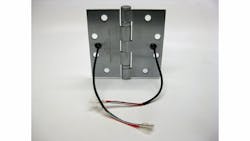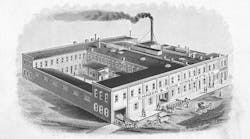About 25 years ago, I was in my late twenties. I had been in the military, had traveled on four continents and was finally ready to settle down. I married my wife and since I was working as a government contractor, I knew I had to find something stable before we even discussed having children.
I looked at all sorts of trades, programs and opportunities. One of my co-workers at the government contract job suggested I try the locksmith field. I applied at a local shop, was hired and learned as much as I could. After a while, I started my own mobile locksmith service. I loved the work, the issue of figuring out how to fix things, the customer interaction and most importantly, the continued need to stay abreast of a rapidly changing industry.
I ended up mostly installing electrified door hardware, both for my locksmith customers and as a sub-contractor for several security integration companies in the Silicon Valley.
Within a few years, I was installing a good mid-six figures of such hardware and by that point, I began to ask how these products I was installing could be made better and, importantly, less expensive and easier to use.
In the mid-1990s, I finally decided to make my own power transfer hinge. If you don’t know the fine details of a power transfer hinge, it is a hinge that has been modified by drilling micro-sized holes through the leaves and running wires from one side of the hinge, through the barrel, and out the other side making sure the wires stay intact after years of use.
The reasons I wanted to make my own hinge were many. Hinges on the market at that time only had very small, low amperage wires. They also had a high rate of failure and most importantly, they were about one hundred dollars each. I decided I could do better.
I went to an engineering firm a couple of blocks away and worked with some engineers to design a new type of power transfer hinge. I wanted a high quality hinge whose wires could be repaired in the field. I also wanted a hinge that would allow for the passage of higher amperage, since much of my work was with electric latch retraction panic devices that required at least 16 amps of current.
When my prototype was finished, I offered my product to the wholesale industry, for about half the cost of any other product available. My company, Marray, Inc., has supplied over 200,000 power transfer hinges to the industry over the past 20 years. I set out to accomplish the following goals, goals that I am proud to say I accomplished:
- My hinge was less expensive to make, thereby making it less expensive to locksmiths.
- It was able to pass high amperage power; thereby making it less expensive to run power to a high amperage device
- It was durable and reliable, with an average of over 800,000 cycles before failure.
My main goal, for the past quarter century, has been to design products that help locksmiths and security professional do their job better. I like things that are efficient, work correctly and that are simple to install and use.
Once my hinge started taking off to good reviews, I decided that there were other products that might benefit from another look.
I was looking around the warehouse one day and noticed boxes and boxes of solenoids I had in inventory. What I was looking at was almost $100,000 of inventory. I asked myself how I could change this. How could I make myself more efficient, reduce inventory, and also appeal to my customers? I designed a solenoid that was both 12 and 24 volt and that could be field changed from fail secure to fail safe, with the use of just a small screwdriver. This solenoid is still installed in all of our name-brand modifications, but also in our own name branded cylindrical lock.
With this new solenoid, I cut my inventory by 75 percent. Instead of having to stock a cylindrical lock set in 12 and 24 volts, and fail safe and fail secure, my customers could stock one lock and never be out of the one they need for a job.
Next, I decided that it might be even more efficient to take this solenoid, make a parts kit and sell the kit to my customers for a better price. This way, they would not order and stock a lock, only to find out that they had the wrong finish. They could carry this kit, a kit that is well below $100, and order a lock from a local supplier, if and when they needed to install an electrified lever set.
Along with creating electrification kits for certain locks, I made a switch for the Schlage L and ND series locks, in kit form. Thus was born the RediRex for the Schlage® L9000 series lock bodies. Without having to remove the cover, a technician can install a Request to Exit switch/monitor switch by simply inserting the patented RediRex into an existing hole in the body. It takes only 10 seconds to add this switch.
Back when I was installing a lot of electrified locks in the San Francisco Bay Area, the fire marshal came by and red tagged the building. He said I was not allowed to install a raceway into a fire rated stairwell door. I had to replace the doors or get approval from the listing agency. This incident finally worked out, but it got me thinking: If locksmiths are not allowed to drill holes in doors for electric hardware, how were we going to keep taking the good-paying access control jobs?
I built a tool that allowed for perfect holes to be drilled in doors, the Dor-Cor Drilling Fixture. I went to one of the largest listing agencies in the world and asked them if they would approve my tool for use in the field. They did not want to commit at that time. Every six months, I would call them or write them, always asking if they had changed their mind.
Finally, in 2007, Intertek decided that it might be a good thing to allow my tool to be used on fire rated doors to drill raceways. The logic was simple: people were drilling holes anyway, and at least this way, they would have training and be under listing agency supervision. Hence, the Perfect Raceway Program was created. It was a long struggle, but I am glad that this program was finally approved. Locksmiths no longer have to worry about being fined or sued for de-listing fire rated doors when raceways are installed, assuming, of course, that the locksmith has taken the course and is a Certified Raceway Installer.
The reason I wrote this article was to say to you, that you too can make a difference. If you have a great idea, think something can be done better and have a genuine idea that actually serves a needed purpose, perhaps you should do something about it. Make the industry better. Keep the locksmith alive. Provide better products at better prices. You might just find that you are a natural at this inventing thing.
I did not start inventing as a way to become rich; thank goodness, I would be disappointed. I started inventing so that I could make better products for a better price for my own locksmith company. I am glad that many other locksmiths have allowed me to share my dreams and have embraced my products.
Ray Zehrung is Founder and President of Marray, Inc., a producer of modified and OEM electrified door hardware. He can be found at www.marray.com, or via twitter @marrayinc or Facebook/marraydoors.






